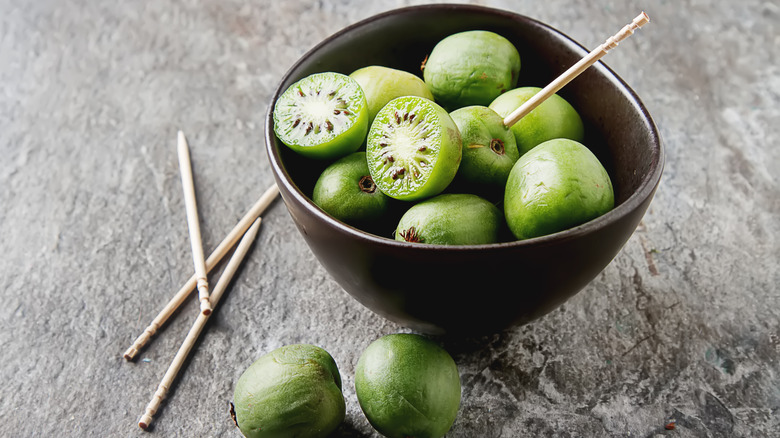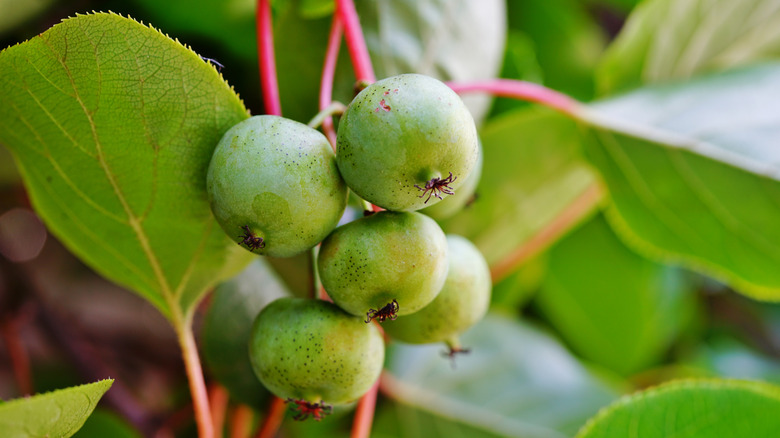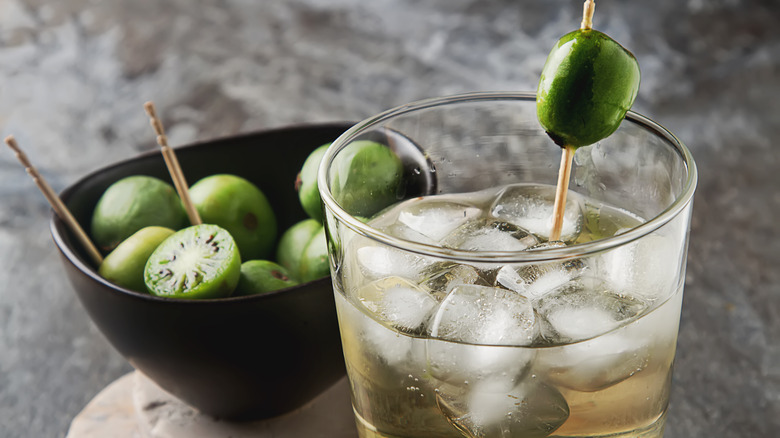Nergi Berries Are A Rising Superfood You Should Keep On Your Radar
Have you ever tried Nergi, the superfood everyone is talking about? Also known as "kiwi berry," this juicy fruit will satisfy your sweet tooth and add an exotic twist to your recipes. It's perfect for summer cocktails, fruit salads, chia pudding, smoothies, and homemade desserts. Plus, it makes a great snack for when you're on the go.
Nergi, or Actinidia arguta, looks like a miniature kiwi fruit, but without the fuzzy skin. It's no bigger than a cherry tomato and packs a lot of nutrition for its size. A 3.5-ounce serving boasts 430 milligrams of vitamin C plus high doses of lutein, carotenoids, quercetin, and other antioxidants. In fact, it's one of the best fruit sources of lutein, a carotenoid that supports eye health and may protect against cataracts, according to 2017 research published in the journal Plant Foods for Human Nutrition.
This kiwi-grape hybrid might become your new fruit obsession — you just have to give it a try. But first, let's see what sets it apart and how to incorporate it into your diet.
Nergi, the kiwi-like fruit with superfood powers
Nergi, or hardy kiwi, is an edible fruit that grows in Russia, China, and some parts of Asia. It's around 1-3 inches long and 1-3 inches wide and has juicy flesh, and its flavor is sweeter and more intense than that of kiwi fruits. But what makes Nergi berries stand out is their high nutritional value. These little guys are packed with vitamins A, E, and B6, calcium, potassium, iron, fiber, and polyphenols, notes the journal Plant Foods for Human Nutrition. Researchers call it a "nutrient-dense superfood," saying it may lower cholesterol levels and reduce inflammation.
It's worth mentioning that Nergi shouldn't be seen as a miniature kiwi fruit, according to Andrea Rigazio, a former sales manager at Ortofruit Italia. "Its bright green coloring makes it distinctive on the shelves of berries, representing a chromatic uniqueness among raspberries and red currants, blue blueberries, and black blackberries," he told Italian Berry. Both Nergi and kiwi belong to the Actinidia genus, but the former is a distinct fruit with unique characteristics.
Kiwi berries have become more widespread in the U.S. and Europe over the past few years, but they are still considered a niche food. Along with cherimoya, lychee, and salak, Nergi is one of those fruits that most people have never heard of. However, you should definitely try it out, considering its bold, exotic flavor and high antioxidant levels. Chances are, you'll find Nergi berries at Trader Joe's, Whole Foods Market, and other supermarket chains.
How to eat Nergi berries to reap their benefits
This juicy fruit can be eaten whole without removing its skin or seeds. Enjoy it as is, mix it into smoothies and fruit juices, or use it in baked goods. Note that cooking affects the antioxidant content of most fruits, so it's best to eat these berries raw. For example, you can mix them with bananas, chia seeds, kale or spinach, and almond milk to make a delicious smoothie bowl. Top it with almonds, walnuts, flaxseeds, or pomegranate seeds for extra crunch.
You can use Nergi berries in most recipes that call for tropical fruits like kiwi or pineapple. They're also a delicious addition to waffles, pancakes, granola, or even savory dishes, such as quinoa salad.
As far as storage goes, you can keep them at room temperature for up to three days or in the fridge for up to one week. Alternatively, cut them into halves and freeze them for later use.


